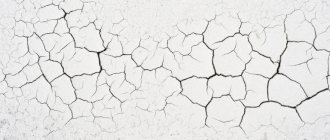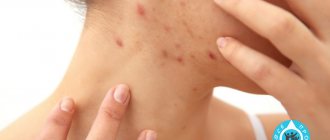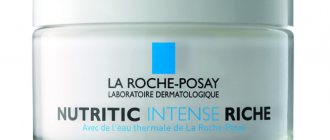Human skin protects the body from aggressive environmental influences. Sensitive skin itself needs protection. Without special care, it loses the ability to perform its basic functions, the epidermis is depleted, provoking the development of serious dermatological problems. 50% of success depends on how accurately the causes of hypersensitivity are identified. They can be explained by the negative influence of both internal and external factors.
Signs of sensitive facial skin
Skin is a protective barrier of the body that protects it from the negative effects of the environment. If the integuments are too sensitive, they lose tolerance to attacks from irritants and themselves need protection.
Manifestations of increased susceptibility of the dermis vary from person to person. In most cases, they are caused by thinning of the epidermis and the development of allergic reactions. In cosmetology, this type of dermis is not distinguished as a separate type. It can be dry, oily or combination. In the first case, increased sensitivity occurs against the background of a lack of fluid and fat in the cells. In the second, it becomes the result of increased bacterial activity, provoked by increased secretion production.
Signs of sensitivity vary depending on the type of dermis. Dry susceptible is characterized by:
- peeling;
- persistent inflammation (often associated with the use of cosmetics);
- tightness;
- pallor;
- itching;
- early appearance of wrinkles;
- rosacea (presence of spider veins).
Symptoms of oily sensitive skin:
- closed comedones (bumps of different sizes);
- clogged pores that look like blackheads;
- greasy shine;
- blackheads
Combination dermis manifests itself with signs characteristic of both dry and oily types. Only they are distributed among areas, depending on the type of cover. How to care for sensitive facial skin depends on which problems are most pronounced.
Common symptoms of susceptibility are discomfort, swelling, tenderness, burning sensation, rapid onset sunburn and red spots of varying intensity.
What determines skin sensitivity?
At the same temperature outside, one person wraps himself in a coat, another walks with an open jacket, and a third is content with a sweater. Do they have different skin? No, everyone’s skin is the same, although it has a personal, unique pattern - a property used by criminologists. Simply, skin sensitivity depends on:
- Places of birth and residence - if you gather three people in one place: an African, a European and a northerner, then at plus 18 degrees Celsius the first will be chilly, the second will be normal, and the third will be warm.
- The places where this area of skin is located on the body - the skin of the face, open to all weather, tolerates heat and frost more easily than the skin of usually closed parts of the body.
- Hardening the body - some people wrap themselves in clothes in the summer, as soon as the north wind blows, while others dive into icy water and are happy with their swim.
Redness of the facial skin
Redness is characteristic of both dry and oily dermis. In the first case, they occur due to irritation or dehydration, in the second - due to the inflammatory process.
People with fair skin, redheads or blondes are more prone to hyperemia. In dark-skinned people, the redness is somewhat hidden by the dermis and is less noticeable. There are many reasons for changes in the color of the integument: from a natural reaction to external stimuli to serious pathologies.
Causes of redness
Sensitive skin turns red more often than normal skin under the influence of external factors. A physiological change in color can be provoked by:
- emotional arousal;
- hot weather;
- alcohol;
- active physical activity;
- uncomfortable posture (when the head is below the lumbar level for a long time);
- consumption of very hot or spicy foods;
- sudden temperature change;
- taking potent medications.
The listed causes of redness are natural, but sometimes redness is a sign of the development of a disease.
Possible ones:
- hypertension;
- sun (heat) stroke;
- allergy;
- dermatological disease (eg rosacea);
- hormonal disbalance;
- diabetes;
- liver pathologies;
- hypothyroidism;
- pancreatic diseases.
Caution: Facial redness may be a symptom of carcinoid syndrome, a precancerous condition of the intestine.
Before you begin to restore a beautiful complexion, you need to undergo an examination. When redness appears due to any pathology, you need to focus on treating the underlying disease. If they are caused by the characteristics of the dermis, the situation can be corrected with the help of special cosmetics.
How to recognize the problem?
Any skin type can be sensitive. The special susceptibility of the skin surface to irritants often accompanies a person throughout his life, but sometimes manifests itself only at certain periods of time. Signs of pathology:
- Excessively whitish tint of the skin (due to a thin layer of skin and a lack of pigment).
- Tightening sensation after performing hygiene procedures.
- Irritations that occur “out of the blue” (rashes, redness, blisters, etc.).
- Tendency to form pigment spots.
- Burning, swelling, tingling, redness and itching are felt after almost every touch of the skin.
- Severe peeling.
- Susceptibility to ultraviolet rays (causes burns).
The situation is typical for people with blond or red hair and light eyes. The reaction can be observed on a specific area of the body (hands, face, scalp, etc.) or on the entire surface of the skin at once. If signs of sensitive facial skin are only partially present, a simple test will help you determine more accurately.
Test
Draw a stripe on the cheek or inner surface of the forearm with a non-sharp object (a ballpoint pen cap will do). The action provoked the appearance of a reddish line on the skin; note the period of time required to restore normal color. An interval of more than 2 minutes indicates increased sensitivity.
Factors provoking changes in the dermis
Very sensitive skin can react to any external or internal influences:
- Climate changes (sharp gust of wind, frost, sun rays, dry or high humidity, heat, etc.).
- Medicines (for oral and external use).
- Cosmetics and salon procedures (peelings, exposure to radio frequency or laser radiation, ultrasound).
- Changes in hormonal levels (changes in the phases of menstruation, menopause, pregnancy, pathologies of the endocrine system).
- Clothing material.
- Synthetic detergents (powder, rinse aid, bleach).
- Respiratory infections, a period of weakening of the body's immune forces.
The causes of skin reactions may vary; to normalize the situation, it is advisable to know what irritant sensitive skin reacts to and eliminate its effect completely.
Care for sensitive skin
The main task of caring procedures is to reduce the risk of a reaction to provoking factors.
To maintain health, you need to pay attention to such areas of care as:
- cleansing;
- hydration;
- protection;
- nutrition.
Attention: it is better if a cosmetologist selects cosmetics for sensitive skin!
All products must correspond to the type of dermis and the age of the person. This is the only way to avoid deterioration of the epidermis.
Dry facial skin
The most important element of caring for dry sensitive skin is cleansing. You definitely need to wash your face in the morning and evening. This type of dermis reacts poorly to tap water and begins to peel and crack. For the procedure you need to use special tools. For example, micellar water and hydrophilic oils. They can be replaced with vegetable oil or mineral water. The liquid should be warm, steaming and ice rubdowns should be avoided.
You should wash your face according to this scheme:
- Using your hands, apply the oil evenly onto your face.
- Massage lightly.
- Pour micellar water into your palms.
- Rinse (it is better to repeat several times).
- Blot dry with a soft paper towel.
Nutrition for oily and problem skin
Those with oily and problem skin first of all need to reduce the amount of sweets and dairy products.
These products do not cause acne, but regular consumption of sweets and milk, especially in large quantities, can provoke rashes.
Conversely, reducing the glycemic load, that is, reducing the amount of carbohydrates in your diet, especially fast carbohydrates:
- Sweets
- Baking
- Chips
- Sweet carbonated drinks
Limiting dairy products will also help improve acne. In addition, those with oily and problem skin are advised to regularly include foods rich in vitamin A in their diet, such as:
- Carrot
- Tomatoes
- Spinach
- Parsley
- Sorrel
- Brocolli
These products will help reduce sebum secretion and improve the condition of oily and problematic skin.
Peeling for sensitive skin
The manipulation is very effective. When carried out correctly, it helps to even out the tone of the dermis, remove traces of acne and peeling. Has a general rejuvenating effect. Problematic epidermis is not a reason to completely abandon such procedures. You just need to choose the right peeling for sensitive facial skin. In a beauty salon, people with this type of dermis will be offered superficial chemical peeling (mechanical, medium-deep options are suitable), using alpha hydroxy acids. This method is gentle and causes minimal irritation.
For homemade formulations, use coffee beans ground into powder or oatmeal soaked in water. They are mixed with regular cream, distributed over the face, gently massaged for five minutes, then washed off and blotted the skin with a soft towel.
You can buy a ready-made peeling composition in the store. In this case, you should choose a product based on wax or cream.
Attention: if there are irritations or inflamed areas on the face, peeling is prohibited!
Before the procedure, the dermis must be thoroughly cleaned, and after completion, apply a moisturizing or nourishing cream. You can do peeling (both at home and in the salon) no more than once a month.
Question answer
What to do if your facial skin is very sensitive and cosmetics do not help? In this case, you should contact a cosmetologist or dermatologist for additional cosmetic procedures: easily washed off nourishing masks, biorevitalization, mesotherapy, etc. The procedure is selected individually for each patient.
People often confuse sensitive skin with regular allergies. To be sure, consult your doctor. The allergy appears 3-4 hours after you apply some product. In case of sensitive skin, symptoms should be expected within 10-30 minutes. To protect yourself from an allergic reaction, test cosmetics on the elbow or shoulder area.
Yes, if you have sensitive skin, you should apply products with SPF protection to your face every day.
Cosmetics for sensitive skin
You cannot choose cosmetics for sensitive skin based on the advice of friends. Manifestations of susceptibility are very individual. It is better to first consult with a cosmetologist. If this is not possible, you need to carefully read the composition.
Cosmetics with:
- hyaluronic acid;
- allantoin;
- vitamin E;
- natural oils (for dry type).
If the top five components include: retinol, vitamin C, benzoyl peroxide, you must first conduct a test. Thin skin is prone to allergies; the listed substances can cause irritation, redness, and peeling. For the same reason, you should choose products without fragrances. The reaction can also be triggered by preservatives such as parabens or methylisothiazoline.
For washing, a milk designed specifically for sensitive epidermis is ideal. It will gently remove dirt, leaving a protective layer.
Any foams, mousses or gels should not contain components such as:
- alcohol;
- parabens;
- alkali;
- sodium lauryl sulfate;
- artificial dyes.
To moisturize and nourish, you need to select creams and serums that are suitable for the type of dermis. For dry skin, products based on wheat germ or almond oils are perfect. They must protect from ultraviolet radiation. Women over 30 years old should use a cream with a protection level of at least SPF-20, regardless of the season.
Nutrition for dry, dehydrated and mature skin
Those with dry skin naturally have a weak lipid barrier, and even at a young age, such skin does not retain moisture well. And over the years, the synthesis of epidermal lipids decreases and skin of any type becomes drier.
In addition, any skin can become dehydrated if the lipid barrier is damaged as a result of improper care or unfavorable external factors.
To help such skin, you need to increase your intake of Omega-3 fatty acids, which will help strengthen the lipid barrier and reduce skin dryness. To do this, regularly include in your diet:
- Fatty fish, such as mackerel, salmon or trout
- Flaxseed and olive oil
- Flax seeds
- Nuts
And don’t forget to drink enough water, at least 1-2 liters a day.
Home Remedies
Traditional medicine methods improve the condition of sensitive skin no worse than expensive branded cosmetics.
From the available products you can make an excellent cream for daily use, which protects, nourishes, moisturizes the face, and maintains the normal acid-base balance of the skin.
Prepare the cream like this:
- Melt 20 g of beeswax in a steam bath.
- Add peach (10 g) and shea (5 g) butter.
- Remove from heat.
- Pour in 3 drops of bergamot essential oil.
- Place the resulting composition in a previously prepared jar.
To even out the tone of the dermis and saturate it with vitamins and microelements, you can use homemade masks.
Attention: before use, you must make sure that you are not allergic to the components of folk remedies!
Here are a few recipes:
- grind 10 g of oatmeal with chamomile and plantain in a coffee grinder (5 g of each dry plant). Dilute the powder in mineral water to the consistency of liquid porridge;
- Grind two egg yolks with 10 g of cottage cheese, pour in 5 g of cream. If the mixture is too thick, dilute with green tea;
- dissolve 10 g of rice flour in 20 ml of milk, add 3 drops of sandalwood essential oil;
- Pour 20 g of kelp with mineral water, after 10 minutes pour in 15 drops of grape oil;
- mix the white of one egg, 15 g of honey, 5 ml of strawberry juice until smooth;
- Peel the cucumber and half of the avocado, grate it, combine the mass with 10 g of wheat flour;
- grind a couple of raw potatoes in a blender, add the yolk, 10 g of cream;
- steam 10 g of flakes in green tea, cool, pour 20 ml of kefir, 8 drops of calendula oil into the oatmeal;
- dilute 10 g of cosmetic clay with water, add 5 g of chamomile, 15 drops of jojoba oil.
Apply all formulations to thoroughly cleansed skin, rinse after 20 minutes. For dry epidermis, it is better not to use clay masks; for oily epidermis, oil-based ones.
Home remedies provide complete care, filling the dermis with nutrients and moisture. Preserve its elasticity and youth.
What should you consider when choosing cosmetics?
Be wary of any new cosmetic products. Minimize your use of makeup when possible. Before you add any cosmetic product to your arsenal, make sure that it has been tested in a special laboratory. This applies to both caring and decorative cosmetics. Before purchasing, make sure that the packaging with cream, mask, makeup base, blush or eye shadow says “suitable for sensitive skin.”
Important! Before using new decorative or skincare cosmetics, be sure to check whether they are suitable for your skin. To do this, apply a very small amount of product, be it cream, mask, lipstick, mascara, eye shadow or blush, on your wrist. Observe for 24 hours how your skin reacts to this product. If it is flushed, itchy or scalding, this cosmetics is definitely not suitable for you. Don't hesitate to stop using it.
If you are used to applying foundation to your skin, then instead of cream we recommend that you use powder - compact or loose. The fact is that this toner contains much fewer components that can have a bad effect on the skin, causing rashes or itching. When choosing certain shadows, keep in mind that warm and pastel colors contain fewer harmful dyes that cause an allergic skin reaction.
Before going outside, it is advisable to lubricate your skin with a light day cream made from thermal water, which contains softening fats and moisturizing components. Some people mistakenly believe that herbal creams are most suitable for sensitive skin. However, care products containing calendula, arnica or chamomile extract can be very irritating to the skin, causing it to become red and stinging.
Preventive measures
Sensitive skin doesn't have to look bad. In order to reduce the intensity of manifestations of this feature, you need to:
- Be sure to cleanse your face of decorative cosmetics before going to bed. Regularly arrange makeup-free days;
- avoid stress;
- ensure a sufficient level of humidity in the premises at home and at work;
- during the period of hormonal changes, take vitamin complexes;
- When leaving home, not only apply sunscreen, but also wear a wide-brimmed hat;
- get a good night's sleep;
- spend more time outdoors;
- use cosmetics labeled “for sensitive skin.”
It is very important to normalize your diet. You can improve the condition of the dermis by giving up caffeine, sweets, fatty foods, spices, and spicy foods - such foods provoke the appearance of redness and rashes.
Competent regular care for sensitive skin will make unpleasant symptoms less noticeable. Over time, the symptoms may disappear completely. The skin will become healthier and become less susceptible to negative external influences.
15
Types of skin sensitivity
Ancient primitive animals that did not have eyes, ears, nose and tongue to survive in earthly conditions had receptors in their body that helped them “see”, “hear”, “smell”. Life was not easy for these animals. Gradually, the organs of vision, hearing, and smell were formed to perform the above functions. And yet the skin remains the main organ of sensitivity, because it protects the body from the outside world. There are four types of sensitivity left behind the skin.
Tactile
Sensitive endings are distributed unevenly. There are more of them where the body is more often in contact with external objects. The palm, especially the fingertips, are sensitive to touch, but the stomach and back are more “thick-skinned.” The most sensitive part of a person is the tongue.
Thermal
In order for metabolism in the body to proceed as nature intended, a certain body temperature is necessary. Thermal sensitivity of the skin signals that it is hot outside today, and you are wearing a warm coat. If you do not hear this signal, but stubbornly continue your journey in a warm coat, your internal organs will feel discomfort, your metabolism will be disrupted, which can lead to very unfavorable consequences.
Cold
Hypothermia is worse for humans than overheating. If there are thirty thousand thermal receptors in human skin, then there are eight times more cold receptors, and they are located closer to the surface of the skin.
Painful
Among two million receptor cells, one and a half million are pain receptors. They are the most nimble cells, reacting to external influences almost instantly. This reaction speed prevents many troubles that beset the human body in this world.











